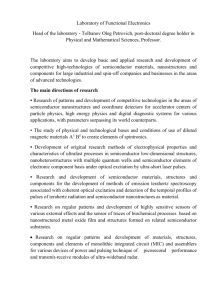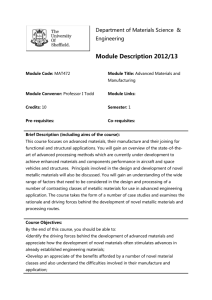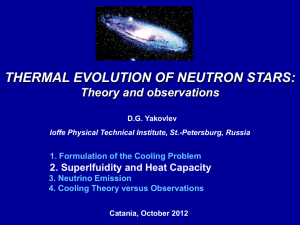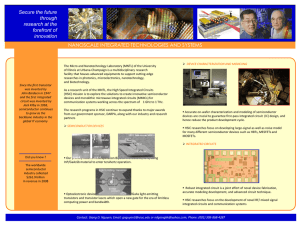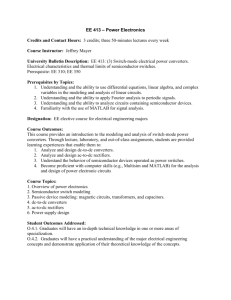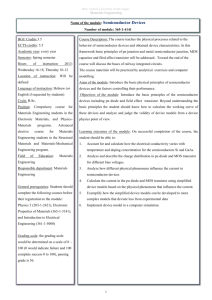THE UNIVERSITY OF WARWICK
advertisement
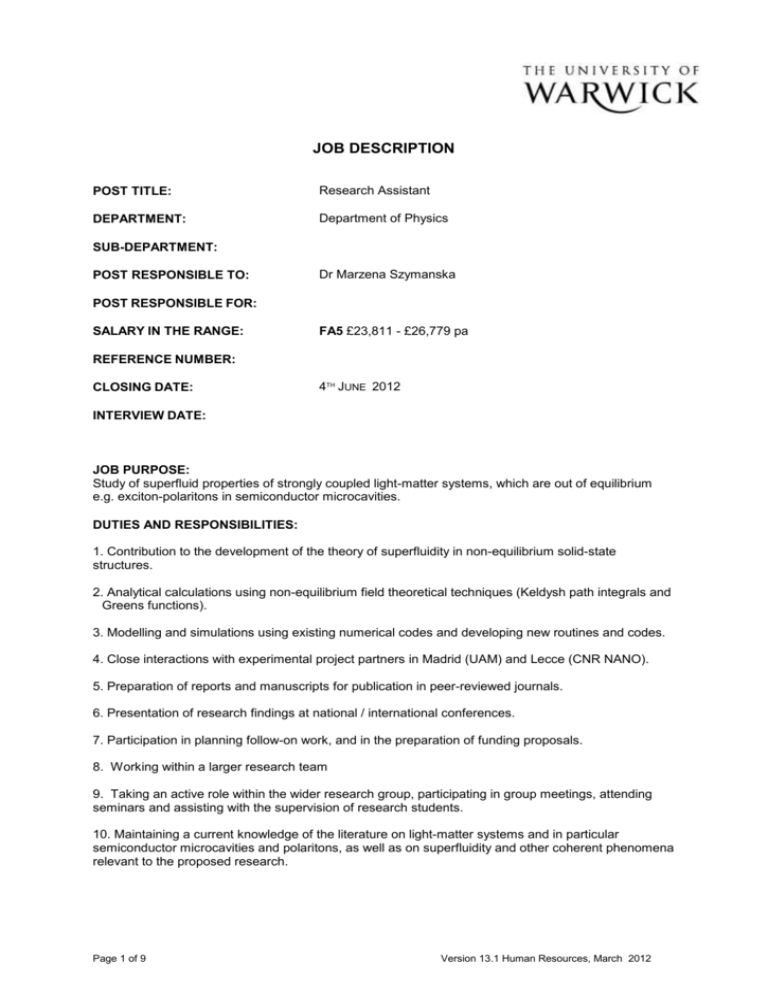
JOB DESCRIPTION POST TITLE: Research Assistant DEPARTMENT: Department of Physics SUB-DEPARTMENT: POST RESPONSIBLE TO: Dr Marzena Szymanska POST RESPONSIBLE FOR: SALARY IN THE RANGE: FA5 £23,811 - £26,779 pa REFERENCE NUMBER: CLOSING DATE: 4TH JUNE 2012 INTERVIEW DATE: JOB PURPOSE: Study of superfluid properties of strongly coupled light-matter systems, which are out of equilibrium e.g. exciton-polaritons in semiconductor microcavities. DUTIES AND RESPONSIBILITIES: 1. Contribution to the development of the theory of superfluidity in non-equilibrium solid-state structures. 2. Analytical calculations using non-equilibrium field theoretical techniques (Keldysh path integrals and Greens functions). 3. Modelling and simulations using existing numerical codes and developing new routines and codes. 4. Close interactions with experimental project partners in Madrid (UAM) and Lecce (CNR NANO). 5. Preparation of reports and manuscripts for publication in peer-reviewed journals. 6. Presentation of research findings at national / international conferences. 7. Participation in planning follow-on work, and in the preparation of funding proposals. 8. Working within a larger research team 9. Taking an active role within the wider research group, participating in group meetings, attending seminars and assisting with the supervision of research students. 10. Maintaining a current knowledge of the literature on light-matter systems and in particular semiconductor microcavities and polaritons, as well as on superfluidity and other coherent phenomena relevant to the proposed research. Page 1 of 9 Version 13.1 Human Resources, March 2012 PERSON SPECIFICATION POST TITLE: Research Assistant DEPARTMENT: Department of Physics The Person Specification focuses on the knowledge, skills, experience and qualifications required to undertake the role effectively. REQUIREMENTS The post holder must be able to demonstrate: ESSENTIAL (E) or DESIRABLE (D) REQUIREMENTS MEASURED BY: a) Application Form b) Test/Exercise c) Interview d) Presentation About to attain a PhD or equivalent in a relevant scientific discipline (e.g. physics, mathematics, engineering). E a) Background in theoretical condensed matter physics and scientific computing. D a) An emerging track record of publications in relevant peer-reviewed journals. D a) Experience in mathematical techniques for dynamical and non-equilibrium systems. D a), c), d) Experience of developing / modifying scientific codes. D a), c) Ability to effectively communicate research through verbal and written presentation. E a), d) Some background knowledge of semiconductor microcavities, strong light-matter coupling and superfluidity. D a), c) Willingness to learn and implement analytical and computational techniques and methodologies. E c) Ability to work independently and as part of a larger research team. E c) Willingness to travel for overseas collaborative visits, and to present research at international conferences. E c) Strong mathematical and numerical literacy. E c), d) Page 2 of 9 Version 13.1 Human Resources, March 2012 JOB DESCRIPTION POST TITLE: Research Fellow DEPARTMENT: Department of Physics SUB-DEPARTMENT: POST RESPONSIBLE TO: Dr Marzena Szymanska POST RESPONSIBLE FOR: SALARY IN THE RANGE: FA6 £27,578 to £35,938 pa REFERENCE NUMBER: CLOSING DATE: 4TH JUNE 2012 INTERVIEW DATE: JOB PURPOSE: Study of superfluid properties of strongly coupled light-matter systems, which are out of equilibrium e.g. exciton-polaritons in semiconductor microcavities. DUTIES AND RESPONSIBILITIES: 1. Contribution to the development of the theory of superfluidity in non-equilibrium solid-state structures. 2. Analytical calculations using non-equilibrium field theoretical techniques (Keldysh path integrals and Greens functions). 3. Modelling and simulations using existing numerical codes and developing new routines and codes. 4. Close interactions with experimental project partners in Madrid (UAM) and Lecce (CNR NANO). 5. Preparation of reports and manuscripts for publication in peer-reviewed journals. 6. Presentation of research findings at national / international conferences. 7. Participation in planning follow-on work, and in the preparation of funding proposals. 8. Working within a larger research team 9. Taking an active role within the wider research group, participating in group meetings, attending seminars and assisting with the supervision of research students. 10. Maintaining a current knowledge of the literature on light-matter systems and in particular semiconductor microcavities and polaritons, as well as on superfluidity and other coherent phenomena relevant to the proposed research. Page 3 of 9 Version 13.1 Human Resources, March 2012 PERSON SPECIFICATION POST TITLE: Research Fellow DEPARTMENT: Department of Physics The Person Specification focuses on the knowledge, skills, experience and qualifications required to undertake the role effectively. REQUIREMENTS The post holder must be able to demonstrate: ESSENTIAL (E) or DESIRABLE (D) REQUIREMENTS MEASURED BY: a) Application Form b) Test/Exercise c) Interview d) Presentation Possess a PhD or equivalent in a relevant scientific discipline (e.g. physics, mathematics, engineering). E a) Background in theoretical condensed matter physics and scientific computing. D a) An emerging track record of publications in relevant peer-reviewed journals. D a) Experience in mathematical techniques for dynamical and non-equilibrium systems. D a), c), d) Experience of developing / modifying scientific codes. D a), c) Ability to effectively communicate research through verbal and written presentation. E a), d) Some background knowledge of semiconductor microcavities, strong light-matter coupling and superfluidity. D a), c) Willingness to learn and implement analytical and computational techniques and methodologies. E c) Ability to work independently and as part of a larger research team. E c) Willingness to travel for overseas collaborative visits, and to present research at international conferences. E c) Strong mathematical and numerical literacy. E c), d) Page 4 of 9 Version 13.1 Human Resources, March 2012 FURTHER PARTICULARS Some details of the EPSRC-funded project that the appointed post-doctoral fellow will work on are outlined below: Superfluidity is one of the most remarkable consequences of macroscopic quantum coherence in interacting condensed matter systems, and manifests itself in a number of fascinating effects, such as for example dissipationless flow of a superfluid via obstacles, quantised circulation, and metastable persistent currents. First observed in liquid Helium in 1937, it is closely related to the phenomena of Bose-Einstein condensation (BEC), and to the Bardeen-Cooper-Schrieffer (BCS) collective state of fermions, which is responsible for superconductive behaviour of some materials. The phenomenon of macroscopic coherence and superfluidity is not restricted to systems close to thermodynamic equilibrium, such as liquid Helium, superconductors and ultra-cold atomic gases. It has also been recently observed in systems far from equilibrium, where a steady-state is obtained by a dynamical balance of driving and losses. Semiconductor microcavities currently play a leading role in the study of non-equilibrium superfluidity. Strong interactions between confined light and bosonic excitations in the semiconductor (called excitons) lead to new quasi-particles - microcavity polaritons, in which interactions can be manipulated externally by changing the driving power and the energy detuning between photons and excitons, and where the matter component can be accurately probed by measuring the properties of the emitted light. An additional advantage of semiconductor microcavities is that the temperatures for BEC and superfluidity in current experiments are of the order of 10K, and are only limited by relatively small dipole interactions between excitons and photons in GaAs. Other materials, such as GaN, have already hosted polariton lasing at room temperature, and it is now only a question of technological progress in manufacturing samples of a better quality (less of the inhomogeneous disorder) for polariton BEC and superfluidity to be realised at room temperature. Quantum collective effects at such high temperatures are likely to lead to device applications, for example in quantum storage and computation, and for transporting light-matter pulses without loss over macroscopic distances. However, properties which characterise non-equilibrium superfluids in dissipative and driven quantum systems are fundamentally different compared to superfluids in thermal equilibrium, and thus we are faced with an exciting opportunity to discover and explore brand-new physical phenomena. This project is aimed at exploring novel superfluid properties of non-equilibrium condensates, using polaritons in semiconductor microcavities. It is a very broad subject since essentially all phenomena discovered and discussed in the context of equilibrium superfluidity are likely to be affected by non-equilibrium. Our aim is to provide a comprehensive theoretical description, and experimental realisation by our project partners, of a broad range of phenomena connected with superfluid behaviour. Page 5 of 9 Version 13.1 Human Resources, March 2012 The Appointed fellow will be based in the Theoretical Physics Group in the Department of Physics at the University of Warwick. The Group holds regular research seminars attracting external speakers from around the country and overseas. The University of Warwick has recently purchased a 3,000-core compute cluster, which will be available to the PDRA with a prioritisation of CPU time. Capabilities for serial task-farm computing are available on campus. The Department of Physics has doubled in size over the past ten years, and now consists of some 60 research-active academic staff and a similar number of research assistants, with strong administrative and technical support. Research in the department was rated as internationally prominent in the 2008 Research Assessment Exercise. Strong connections exist with the department of Chemistry, including the new, shared, Materials and Analytical Sciences building, and with neighbouring Universities through the Science City Research Alliance, and the Midlands Physics Alliance. For further information about the University of Warwick, please visit our website at http://www2.warwick.ac.uk/services/humanresources/jobsintro/furtherparticulars For further information about the Department of Physics, please see our website at (insert link for departmental further particulars). Page 6 of 9 Version 13.1 Human Resources, March 2012
